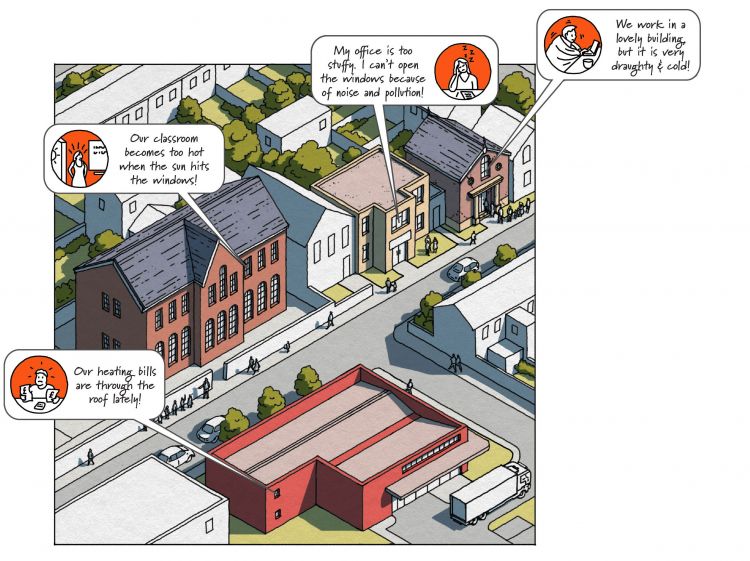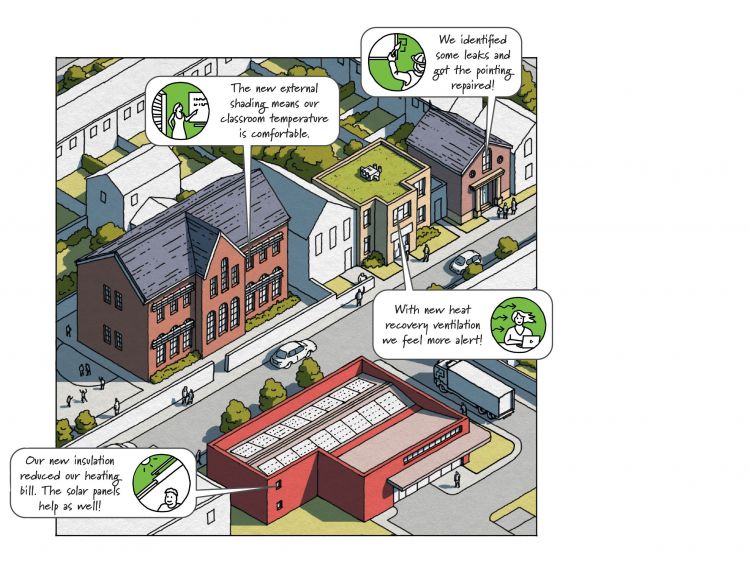The TUC guide to building retrofit at work
Why advocate for retrofit?
Cold and draughty buildings with poor air quality affect our wellbeing and health at work. Running buildings is increasingly expensive due to the cost of living and energy bill crisis, and is the third largest carbon emitting sector globally. Done in the right way, maintenance and retrofit can fix these issues. This leaflet provides suggestions for trade unionists for why and how to start advocating for building retrofit at work.
Comfort and health
Overheating, drafts, mould, damp, and poor air quality, are common issues in the workplace as a result of poor maintenance and lack of insulation. This can contribute to ill health including respiratory conditions & allergies.
Reduce costs and build a working relationship with your employer
The cost of heating and cooling is putting businesses under risk of closure. Improving insulation and replacing inefficient old equipment can slash a building’s energy use, when done correctly. Your ideas for reducing workplace accidents and increasing energy efficiency will appeal to your employer and help build a good working relationship.
Take climate action and mobilise new members
Climate change is a great issue for recruitment and organising, in particular with younger workers. Reducing energy use and decarbonising heat sources can decrease carbon emissions, in many cases up to 60%. Upgrading old buildings emits much less carbon than building new ones. Talking to workers about the unions’ efforts and the support it needs, can help to attract new, active members to your branch.
Talk to workers about it
Talk to all workers, not just members. Have they been too hot or cold at work, or had problems with ventilation or damp?
- Are they feeling OK? Have they got ideas for how to deal with building issues?
- Do they understand how the temperature could be adjusted?
- Are there particular times or parts of their work process when temperatures are a problem?
- What issues have they noticed? (e.g. damp, gaps, cracks in walls)
- Make sure incidents or ill health are reported to your employer and recorded in the accident book.
- Are building works (such as boiler, ventilation, and cooling systems) completed by outside contractors being signed off and handed over by a professional?
How to make retrofit happen
Very simple adaptations can improve energy efficiency as well as health and wellbeing. Starting with suggestions of small, low cost actions starts discussion and prompts action – remember to ask your members if they have ideas! Having an understanding of the benefits of different retrofit measures and existing environmental issues at work helps to be credible and confident in conversation with employers and colleagues.
Quick wins to keep warm in winter, cool in summer
- Move workspaces away from cold or hot surfaces.
- Ensure radiators are not covered. Check them for even temperature.
- Report any draughts, leaking gutters and wet walls for repair.
- Close curtains at dusk.
- Is there enough ventilation? Closing windows for warmth often reduces air quality - you could decide to monitor this.
- Check that appliances aren’t left on when not in use
Quick wins to save energy
- Are your lightbulbs LED?
- Check heating, hot water, and lighting timers – are they on at times they’re not needed?
- Use sensors to track temperature and test turning thermostats down – is it comfortable?
- Visually inspect for draughts and damage in external walls.
The long-term vision
- Airtightness measures; good insulation for walls, roofs and floors; good windows.
- To prevent overheating: outside shading for windows; a secure means of night time passive ventilation; tree / shrub planting.
- Decarbonised heating solutions; ASHP, solar panels to generate electricity and / or hot water, and ventilation with heat recovery.
Work with your employer
- Raise issues on your members’ behalf, framing your negotiations in terms of protecting workers and saving money on energy bills:
- Agree a heatwave plan - see TUC’s guidance on our Linktree.
- Suggest ‘quick win’ savings. • Agree on working together to future-proof your building.
Make a long-term plan with your employer
- Get advice from a specialist. Careful and qualified assessment, design and monitoring is essential!
- Identify who can be involved. What can be done in-house? Are there related training needs?
- Are nearby organisations looking into retrofit? Can you team up?
- Look into available funding sources – there are government grant schemes and loans to help. Investments in energy efficiency tend to ‘pay back’ in 3-10 years.
- Consider opportunities to improve different building issues. Make sure retrofit is good, unionised work! Get your employer to sign up to a Good Jobs charter, or commit to prioritising good jobs as part of the procurement process.

Stay Updated
Want to hear about our latest resources for union reps?
Sign up now to get it straight to your inbox



